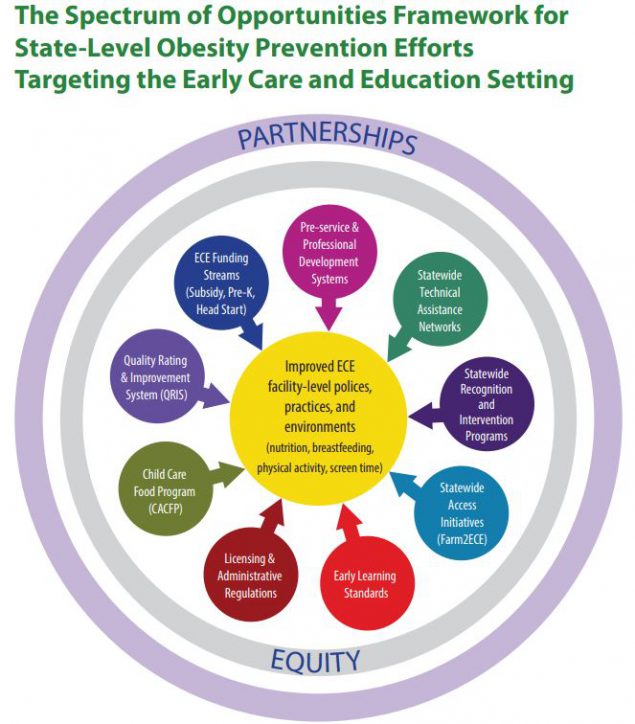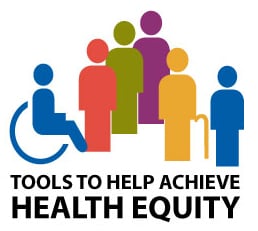Advancing Farm to Early Care and Education (ECE)

Farm to Early Care and Education (ECE) is a set of strategies and activities for the ECE setting. Farm to ECE provides children in the ECE setting the following benefits, according to the National Farm to School Network:
- Increased access to healthy, regionally produced foods through local purchasing.
- Opportunities for hands-on gardening experience.
- Nutrition, food, and agricultural education.
Farm to ECE activities, such as gardening, farm visits, and taste-testing fresh food from local farms, teach children about healthy food by engaging all five senses. Farm to ECE can increase children’s fruit and vegetable intake and willingness to try new fruits and vegetables. This can improve young children’s diet and wellness.
Farm to ECE Benefits:
The Child and Adult Care Food Program (CACFP) is a federal program that provides reimbursements for nutritious meals and snacks served to eligible children and adults enrolled at participating programs.
- Children and ECE providers by helping meet some of the Caring for our Children Standards, that also align with the Child and Adult Care Food Program (CACFP) such as:
- Serve vegetables, specifically, dark green, orange, and deep yellow vegetables and root vegetables.
- Serve fruits of several varieties, especially whole fruits.
- Provide opportunities for children to play outdoors, 2 to 3 times per day.
- Farmers by creating more diversified income streams for regional growers.
- Communities by providing opportunities to build family and community engagement through gardening, gathering food, and visiting farms or food producers’ events.
Getting Started With Farm to ECE:
State Level
- Work through partnerships and coalitions to advance Farm to ECE statewide.
- Find cross-sectoral state partners supporting Farm to ECE through the National Farm to School Network (NFSN).
- If only Farm to School Coalitions exists, engage state partners to include Farm to ECE.
- If no state coalitions exist, consider starting one. Start by reaching out to your State Cooperative Extension to help you identify possible partners.
- Build state capacity.
- Model your work after successful programs such as the CDC/DNPAO-funded state program work with the Association of State Public Health Nutritionists.
- Learn more about available resources such as those on the NFSN Farm to ECE site and Supplemental Nutrition Assistance Program Education (SNAP Ed) toolkit.
- Advancing Farm to ECE.
- Create or revise a State Farm to ECE Strategic Plan, such as Colorado’s Farm to Child Road Map.
- Understand existing federal funding opportunities to support Farm to ECE. [PDF-1.13MB]
- Use the CDC ECE Guiding Framework, The Spectrum of Opportunities [PDF-666KB] to guide statewide farm to ECE work.
Local Level:
- Connect with state-level Initiatives and coalitions or start a local coalition if one does not exist at the state level.
- Build local capacity.
- Connect with your local Child Care Resource and Referral Agency to help engage ECE programs in Farm to ECE initiatives.
- Learn from communities building capacity for engaging in Farm to ECE work. These examples are from the CDC-funded Racial and Ethnic Approaches to Community Health program.
Making a Difference Through Farm to ECE Implementation Grants (FIG)
CDC has supported Farm to ECE initiatives through a cooperative agreement with the Association of State Public Heath Nutritionists (ASPHN) since 2018. This support helped grow 15 Farm to ECE coalitions across the United States. State funds are Farm to ECE Implementation Grants (FIG), and community funding is through CABBAGE: Capacity Building Grants. The National Farm to School Network provides additional technical assistance.
From 2020 – 2021, FIG recipients reached:
219,500 children
1,900 ECE providers
1,206 ECE sites
Engaged:
2,873 children
149 ECE providers
55 ECE sites
From 2020 to 2021, the Mississippi Department of Health and the Farm to School Network established a statewide committee and created a plan for the state. The team developed resources, launched a Farm to ECE website, and held virtual farm tours, cooking demos, farmer visits, and in-person technical assistance for 55 ECE sites. The team piloted farm share deliveries, bringing local farmers to ECE providers to deliver fresh produce. Together, efforts reached nearly 150 ECE providers and benefited nearly 3,000 children by increasing access to healthy, locally grown foods, gardening opportunities, and nutrition standards.
Colorado: Partnership and Equity
Engaged:
500 children
62 ECE providers
Colorado Department of Public Health & Environment supported the Farm to ECE Coalition in creating a roadmap and 3-year action plan to help make programs self-sufficient. Nine pilot sites worked to increase the capacity to grow and serve fresh local food and teach children about agriculture and nutrition. In the first year, the coalition trained 62 ECE providers, worked with providers to establish and maintain 7 gardens, and created more than 30 resources in multiple languages, such as Colorado’s Farm to Child Guide (addressing health equity goals) that benefited more than 500 children enrolled in these ECE sites.
Iowa: Supporting Child and Adult Care Food Program (CACFP) and Equity
Engaged:
500 children
27 ECE sites
73 local food producers and farmers
Iowa Farm to School & Early Care Coalition (IA FSECC) led a successful pilot, Local Food Makes Cents: For Iowa Kids and Farmers. The pilot increased Child and Adult Care Food Program (CACFP) reimbursements to 27 ECE providers to support the purchase and serving of local food. This allowed ECE sites to use CACFP funding to buy $30,000 in local foods from 73 local food producers and farmers and resulted in 500 children having better access to affordable, locally grown fruits and vegetables. The success of this pilot helped IA FSECC secure $1 million in state funding to support expansion of Local Food Makes Cents, which will benefit children across Iowa enrolled in ECE sites.
Washington State: Professional Development, Partnership, & Equity
Engaged:
2,414 children
1,330 providers
1,040 ECE sites
Through the FIG program, Washington State developed its Farm to ECE Coalition in 2020 and strengthened its state Farm to ECE initiatives. The coalition is working to grow equitable and sustainable programs across the state. Its online library hosts free trainings taken more than 2,300 times, success stories, and resources, including Spanish language and tribal resources. Its work to increase access to and grow healthy and traditional foods has expanded the capacity of 1,330 providers and 1,200 partners through training. The work has directly benefited 2,414 children and 1,040 ECE sites. For example, Viva Farms in Skagit County partnered with Child Care Aware of NW Washington and a local public health organization to bring gardening, Farm to ECE curriculum, and fresh produce to 33 family home childcare programs—19 serving children from diverse cultural backgrounds. Children attending the Suquamish Tribe’s ECE site on the Kitsap Peninsula now benefit from traditional foods and activities.
Michigan: Statewide Intervention and Equity
Engaged:
1,148 children
31 ECE sites
Michigan expanded a Farm to ECE pilot program with a focus on equity. The Michigan Farm to ECE team streamlined the pilot application process by making applications jargon-free and easy to access, read, and complete. Michigan received 65 applicants for 31 spots. As of 2021, the pilot had provided $14,479 in Farm to ECE funding, reaching 1,148 children. The pilot extends across 17 Michigan counties, and initial results show that more than half of sites improved “best practices” in Farm to ECE using a national, validated self-assessment tool. This pilot has encouraged more Farm to ECE providers to enroll in Michigan’s Ten Cents a Meal program, laying the groundwork for long-term benefits for Michigan’s children and its food system.
Ohio: Equity, Partnership, Technical Assistance Networks, Statewide Intervention Initiative
Engaged:
1,685 children
15 ECE sites
Ohio’s Farm to ECE Coalition created an equity-centered roadmap (plan for the future) and piloted Farm to ECE at seven Head Start sites, three center-based sites, and five home-based sites, all of which serve a majority children who qualify for free or reduced-price lunches. In 1 year, the pilot has reached 1,685 children and connected the sites to more than 15 local food producers and food businesses they can buy from in Ohio. Pilot sites also received indoor seed starter materials and outdoor raised bed garden supplies to help illustrate how food grows and becomes the local foods that children eat daily. Children at the pilot sites grew vegetables, ate local foods as snacks or meals, visited local farmers’ markets and orchards, and learned how to make honey from a local beekeeper. The pilot program provided examples of best practices for ECE sites and farm to ECE advocates.
District of Columbia: Access to Nutritious Foods and Equity
Engaged
500 children
33 ECE centers
56,000 pounds of local food
The District of Columbia Farm to ECE team implemented “farm share bags” and “childcare shares” among 33 ECE centers. Farm share bags are weekly bags of seasonal, local produce designed to provide families with access to fresh foods at home. Families and ECE staff can buy these bags at a subsidized cost when using federal nutrition benefits, such as Supplemental Nutrition Assistance Program (SNAP) and Women, Infants, and Children (WIC). Participants can also pay with cash or card. Similarly, childcare shares are low-cost weekly deliveries of seasonal fruits and vegetables that ECE centers use to prepare meals and snacks for their center. DC created a Market Share blog accessed via a QR code on the share bag. The blog contains information about the bag’s weekly produce, including recipes that can be created with each week’s contents. In addition, the DC team created the Produce 101 booklet for ECE providers to identify, store, and prepare local vegetables. More than 56,000 pounds of local food have been delivered to ECE sites and families and benefited the families of 500 children enrolled in ECE centers in DC in 6 months.
Advancing Health Equity
FIG recipients expanded their work in key equity areas by:
- Expanding coalitions: Expanding and diversifying Farm to ECE coalitions.
- Creating cultural/linguistic translation: Translating materials into different languages and making them applicable to other cultures, including by substituting culturally appropriate foods.
- Prioritizing federal subsidies: Promoting existing federal programs that support ECE providers caring for families with low incomes. Program examples are the Child and Adult Care Food Program (CACFP) and the Child Care and Development Fund (CCDF).
- Prioritizing BIPOC (Black, Indigenous, People of Color) and women farmers: Prioritizing local food sourcing from farmers of color and women-owned farms.
- Providing health equity trainings and technical assistance: Training opportunities and technical assistance focused on implementing policies and practices that advance health equity.
- Using health equity frameworks/analysis: Using equity frameworks and assessments) to inform their work, such as the National Farm to School Network: Racial and Social Equity Assessment Tool.
Farm to ECE Resources
- Farm to ECE Grantees Programs – ASPHN
- National Farm to School Network
- Enhancing Young Children’s Access to Local Foods and Farm to ECE: Federal Funding Opportunities
- Growing Head Start Success with Farm to Early Care and Education
- Growing Minds: Farm to Preschool Toolkit (North Carolina)
- Farm to Preschool Fact Sheet (US Department of Agriculture)
- Natural Learning Initiative: Gardening Activity Guide (North Carolina State University)
- Harvest for Healthy Kids
- Tribal Farm to ECE (Washington State)


